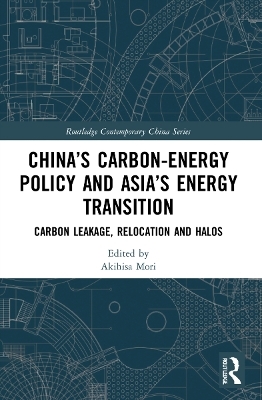
China’s Carbon-Energy Policy and Asia’s Energy Transition
Routledge (Verlag)
978-1-032-04189-6 (ISBN)
China shows a co-evolution of carbon-energy policy and energy transitions from coal to renewables. Assessing how the policy intensifies pressures and motivations to Chinese companies, chapters in this edited volume analyse how the policy has changed energy and CO2 emissions in Asia through the lens of carbon leakage, relocation, and halos. Contributors present in-depth studies on China’s investments and exports, and also its impacts on Indonesia, India, Vietnam, and Japan. Using applied computable general equilibrium and scenario input-output analyses, chapters investigate if regional electricity connectivity reduces new coal power investments through efficiency gain. Arguing that China is shifting from the world’s factory to the leading innovator and Asia's demand centre, it is ultimately demonstrated that China is likely to achieve climate targets whereas Asia to increase CO2 emissions and economic reliance on China.
China’s Carbon-Energy Policy and Asia’s Energy Transition will be of significant interest to students and scholars of energy, environment, and sustainability studies, as well as Chinese studies and economics.
Akihisa Mori is an Associate Professor at Kyoto University and a vice president of the Asian Association of Environmental and Resource Economics. His research focus is on sustainability transitions and China’s Belt and Road Initiative. His other publications with Routledge include China's Climate-Energy Policy: Domestic and International Impacts.
Part 1: Energy Transition and Carbon Leakage, Relocation and Halos: Concepts and Framework 1. Carbon leakage, relocation, and halo: Concept and framework to understand impacts of China’s carbon-energy policy 2. Struggles for energy transition in the electricity system in Asian countries: A system complementarity perspective Part 2: China's Energy and Industrial Transformation as Push Factors 3. Economic and environmental Impacts of power supply configuration change in China: An application of scenario input-output analysis 4. Change of China’s renewable energy policy and its impact on domestic PV companies 5. Do Chinese power companies employ investments in foreign power projects as a geographical diversification strategy to stringent regulations? Part 3: Carbon, Leakage, Relocation and Halos Effect in Host Countries 6. The Economic and carbon impact of China’s outward foreign direct investment in the power sector 7. The effect of renewable energy policies on import from Asian countries: Evidence from solar PV/wind energy with matching econometrics 8. The role of China in the development of coal and renewable energy plants in Indonesia 9. India’s energy transition: Is China an inhibitor or a catalyst?’ 10. Impact of Chinese renewable technology export on Japan’s energy transition: The case of solar photovoltaic industry 11. Generating or receiving carbon leakages?: An examination of China in Asia Part 4: Countermeasures and future challenges 12. The implications of East Asia electricity market integration on Southeast Asian economies and carbon emissions 13. China’s carbon-energy policy and Asia’s energy transition from carbon leakage, relocation, and halos perspectives: Conclusions and the future
| Erscheinungsdatum | 06.12.2021 |
|---|---|
| Reihe/Serie | Routledge Contemporary China Series |
| Zusatzinfo | 48 Tables, black and white; 86 Line drawings, black and white; 86 Illustrations, black and white |
| Verlagsort | London |
| Sprache | englisch |
| Maße | 156 x 234 mm |
| Gewicht | 453 g |
| Themenwelt | Naturwissenschaften ► Biologie ► Ökologie / Naturschutz |
| Naturwissenschaften ► Physik / Astronomie | |
| Sozialwissenschaften ► Politik / Verwaltung ► Staat / Verwaltung | |
| Sozialwissenschaften ► Soziologie ► Spezielle Soziologien | |
| ISBN-10 | 1-032-04189-7 / 1032041897 |
| ISBN-13 | 978-1-032-04189-6 / 9781032041896 |
| Zustand | Neuware |
| Informationen gemäß Produktsicherheitsverordnung (GPSR) | |
| Haben Sie eine Frage zum Produkt? |
aus dem Bereich


